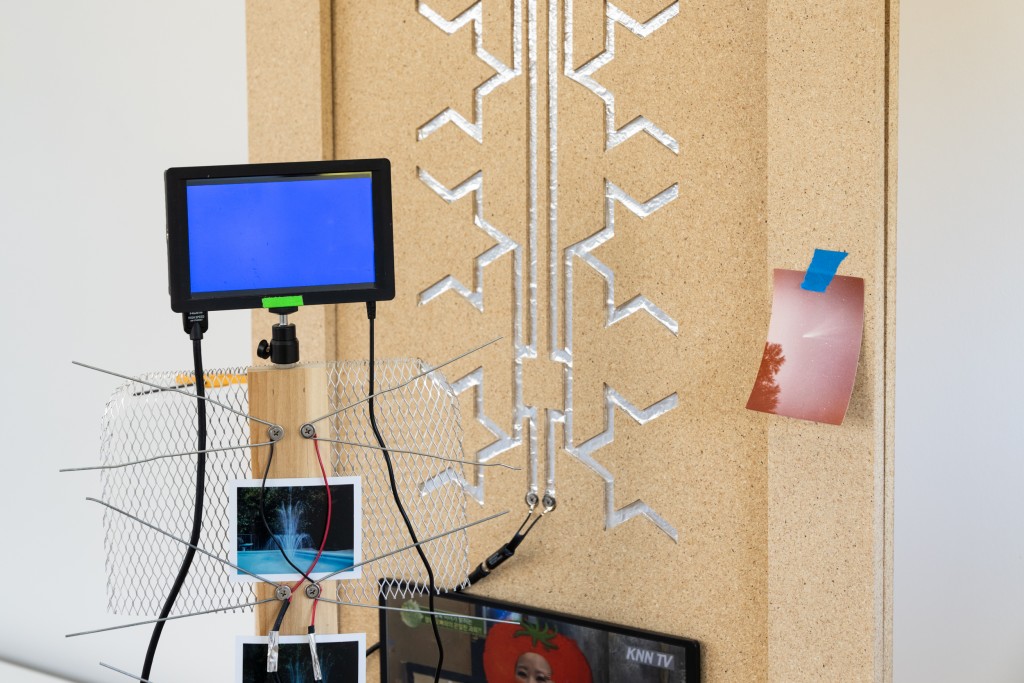This Dallas nature preserve is tainted by nearby industrial plants. That’s exactly why it appeals to artist Trey Burns.
ArtandSeek.net December 2, 2021 29Trey Burns is fascinated by those liminal moments where the man-made world juts up against the natural one: a flock of geese in a parking lot, a golf course neighboring a nature preserve or suburban homes built atop ancient prairie grasslands.
The Dallas artist and co-founder of Sweet Pass Sculpture Park has a new solo show exploring these “Recent Landscapes” at ex ovo projects in West Dallas. Rather than meeting in a cold, stale recording studio, I invited Burns to pick a corner of Dallas that embodied his work.

Trey Burns is a lens-based artist whose work explores built environments and histories of place. Photo courtesy of ex ovo projects.
“We’re in Goat Island Preserve, which is this park and set of hiking trails that’s south of Dallas off the Trinity River,” Burns said. “The little bit that I know about this place is that it used to be farmland that was donated. It’s prone to flooding, so not many people live around it.”
What makes Goat Island unusual is what surrounds the nature preserve near Hutchins in southeastern Dallas County. To the north, there’s a wastewater treatment plant and a recycling facility. Down south, you can hear the hum of cement and concrete plants. A steady stream of semi-trailer trucks drive by the park’s entrance.
“It’s like this beautiful, peaceful place, but it’s bracketed by a lot of industries,” Burns said. “But then, this is where I’ve seen the most wildlife anywhere in North Texas, so it’s kind of an interesting mash up.”

Goat Island Preserve is a 501-acre park located in southeastern Dallas County, near Hutchins. Photo by Miguel Perez.
Like Goat Island, the new exhibition features a collection of sculptures, videos and photos amassed during the past year that show “complicated landscapes where a couple of worlds might layer up on each other or kind of crumple into each other,” he said.
The show is a nod to “New Topographics,” an influential 1975 photo exhibition at the International Museum of Photography in Rochester, New York. The show featured unvarnished images of natural landscapes juxtaposed with industrial and suburban development.
“It just became really clear when I was doing these drives and exploring that these sort of interesting landscapes existed [in North Texas] in large numbers,” Burns said. “I was just taking a lot of images. Then, I started to collect and put together a reel of these things, which became the basis for the exhibition.”
Once Burns and I head down the Horned Frogs Trail, nature assumes control. The hum of industrial plants gives way to the rustle of leaves, and there are glimpses of the Trinity River as we make our way deeper into the preserve.
“It doesn’t feel like anywhere else. It’s almost like you’re out in the country,” Burns said. “But then, you go a little bit and you see an asphalt manufacturer and then there’s like a highway that just kind of juts out of nowhere. It’s just sort of wild.”
Burns says his show is about “ways of looking.” When we slow down and pause in places we typically pass over, novel ecologies appear.
“It’s a way to make sense of where you are, and this is probably like a coping thing for me,” he said. “I’m always just trying to figure out what’s going on. Why is something like this? Why does it look like this? Why did they put this here?”
His imagery is set inside multiple structures the artist has fabricated himself. One of them is made of welded steel and modeled after the porch posts he sees around his East Dallas neighborhood. The other is made of aluminum foil and wood.
“I have an antenna piece that I have been working on that’s based on some plans that I found on the internet for DIY antennas,” Burns said. “So they’re made out of everyday household materials like coat hangers and and aluminum foil. The objects are really beautiful and sculptural in and of themselves, but they’re also like functioning, and I’m tuning in to the television signals that are available in the gallery.”
Burns said his examination of different landscapes goes beyond the visible environment. Television transmissions are as much a part of the manmade world as factories and highways.
“Digital TV signals seem like a legacy technology, but it’s how a lot of people get their information and entertainment,” he said. “I’ve kind of pulled it out of the air, and I’m asking what does that technology say about a place?”
You can see “Recent Landscapes” at ex ovo projects through Dec. 18. Burns plans to host an artist talk with a baked potato bar on closing day at the gallery.
Got a tip? Email Miguel Perez at mperez@kera.org. You can follow him on Twitter @quillindie.
Art&Seek is made possible through the generosity of our members. If you find this reporting valuable, consider making a tax-deductible gift today. Thank you.











